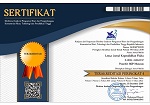PENERAPAN TEORI JEROLD E. KEMP BERBASIS METODE PQ4R UNTUK MENINGKATKAN AKTIVITAS DAN PRESTASI BELAJAR SISWA KELAS X TSM PADA MATERI POKOK PROGRAM LINEAR DI SMKN 1 GERUNG TAHUN PELAJARAN 2012/2013
DOI:
https://doi.org/10.33394/j-lkf.v1i1.72Keywords:
Jerold E. Kemp theory based on PQ4R method, Activity and Learning Achievement, Linear Program.Abstract
Mathematics learning in SMKN 1 Gerung considered by some students is a difficult and tedious lesson. Learning is still teacher-centered and leads to reduced activity and enthusiasm for students in learning. The purpose of this study is to improve student activity and achievement using Jerold E. Kemp-based PQ4R method on the subject matter of linear program of students of class X-TSM SMKN 1 Gerung academic year 2012/2013. This study was conducted using classroom action research (PTK). The number of subjects in this study was 24 people. Observation data of student and teacher activity is qualitative and student learning evaluation is quantitative data. The instruments used are RPP, student and teacher observation sheets, LKS, and evaluation tests. The results showed that there is an increase in student activity and achievement from first to second cycle. Increased student learning activities can be seen in the results of the first cycle of observation I (the category is quite active) and at the second meeting (active category). In cycle II at session I and II (active category). The completeness of learning cycle I is 56.52%, because in the first cycle of classical completeness has not met the required ≥85% of students who got the value of ≥75 then the research continued into the second cycle. Finally, through the improvements obtained classical completeness in the second cycle reached 87.50%. It can be concluded that the application of Jerold E. Kemp theory based on PQ4R method can increase student activity and achievement.
References
Arikunto. S. dan Suhardjono. 2011. Penelitian Tindakan Kelas. Jakarta: Bumi Aksara.
Djamarah, S. B. 2012. Prestasi Belajar dan Kompetensi Guru. Surabaya : Usaha Nasional.
Hamalik, O. 2011. Proses Belajar Mengajar. Jakarta: Bumi Aksara.
Mahayukti, G. A. 2003. Pengembangan Model Pembelajaran Generatif Dengan Metode PQ4R Untuk Meningkatkan Kualitas Pembelajaran Matematika di Kelas IIB SLTP Lab IKIP Negeri Singaraja. Jurnal. IKIP Negeri Singaraja
Mardapi, D. 2008. Tekhnik Penyusunan Instrumen Tes dan Nontes. Jogjakarta: Mitra Cendikia
Pujawan, I. G. N. 2005. Implementasi Pendidikan Matematika Realistik dengan Metode PQ4R berbantuan LKS dalam Meningkatkan Motivasi dan Prestasi Belajar Matematika Siswa SMP Negeri 4 Singaraja. Jurnal Pendidikan dan Pengajaran. IKIP Negeri Singaraja
Rizqiana, N. 2013, Pengaruh Strategi Pembelajaran PQ4R Terhadap Pemahaman Matematika Siswa Kelas VIII SMP Negeri 6 Kota Cirebon. Skripsi. IKIP Negeri Cirebon
Roestiyah. 2008. Strategi Belajar Mengajar. Jakarta: Rineka Cipta
Rusman. 2012. Model – Model Pembelajaran. Jakarta: Rajawali Pers
Slameto. 2010. Belajar dan Faktor – Faktor Yang Mempengaruhi. Jakarta: Rineka Cipta
Sudjana, N. 2011. Penilaian hasil Proses Belajar Mengajar. Bandung: Remaja Rosdakarya
Sujana, I. M. 2010. Workshop Penelitian Tindakan Kelas. Lombok: Arga Puji Pers
Suprijono, A. 2012. Cooperative Learning. Yogyakarta: Bumi Aksara
Syahrir, 2010. Metodologi Pembelajaran Matematika. Yogyakarta : Naufan Pustaka
Titian, A. 2012. Penerapan Metode Pembelajaran PQ4R Untuk Meningkatkan Aktivitas dan Prestasi Belajar Siswa
Downloads
Published
How to Cite
Issue
Section
Citation Check
License
Authors who publish with Lensa: Jurnal Kependidikan Fisika agree to the following terms:
- For all articles published in Lensa: Jurnal Kependidikan Fisika, copyright is retained by the authors. Authors give permission to the publisher to announce the work with conditions. When the manuscript is accepted for publication, the authors agree to automatic transfer of the publishing right to the publisher.
- Authors retain copyright and grant the journal right of first publication with the work simultaneously licensed under a Creative Commons Attribution-ShareAlike 4.0 International License that allows others to share the work with an acknowledgment of the work's authorship and initial publication in this journal.
- Authors are able to enter into separate, additional contractual arrangements for the non-exclusive distribution of the journal's published version of the work (e.g., post it to an institutional repository or publish it in a book), with an acknowledgment of its initial publication in this journal.
- Authors are permitted and encouraged to post their work online (e.g., in institutional repositories or on their website) prior to and during the submission process, as it can lead to productive exchanges, as well as earlier and greater citation of published work (See The Effect of Open Access).

This work is licensed under a Creative Commons Attribution-ShareAlike 4.0 International License.

.png)

